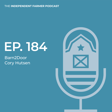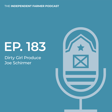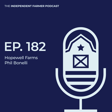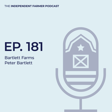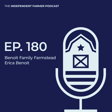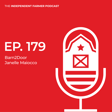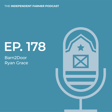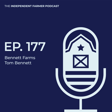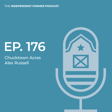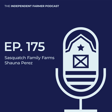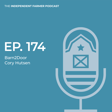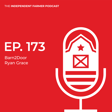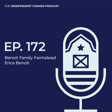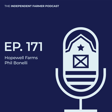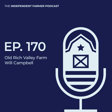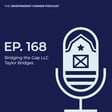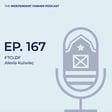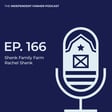Become a Creator today!Start creating today - Share your story with the world!
Start for free
00:00:00
00:00:01

Conference Keynote: Price with Paul Greive
Listen to Paul Greive challenge the 'cost-plus' pricing model in his Keynote Session on Price from the DIRECT 2020 Farm Conference. Learn why fewer options are better, from bundles to flat-rate pricing.
Show Notes:
Link to Tom Bennett's talk at DIRECT 2020 (mentioned in the episode):
https://www.directfarmconference.com/price-tom-bennett
Read more here:
https://www.barn2door.com/blog/direct-farm-conference-speaker-paul-greive-of-pasturebird?__hstc=222833540.27d14b09b2dd22de361d173a26cb9b0e.1633454048048.1634057568637.1634070995079.5&__hssc=222833540.8.1634070995079&__hsfp=122364210
Transcript
Introduction to Farm Success Levers
00:00:03
Speaker
Welcome to the Direct Farm podcast, the weekly listen for farm selling direct. We'll talk about the four levers for farm success, which are quality, brand, price, and convenience. We'll hear from outside industry experts and producers like you to delight your customers to save time and to increase your direct farm sales and business. We're glad you're here.
Pricing Insights from Direct Farm Conference
00:00:25
Speaker
Welcome back, everyone. We are on our third week of our four-week recap from the 2020 Direct Farm Conference, and this week we're going to talk about Price. We heard about quality from Paul Dorrance. We heard about brand from Nona Jones last week. This week we're going to talk about Price with Paul Greve. He's the CEO of Pasture Bird, which is the largest pastured poultry producer in the U.S.
Paul Grieve's Journey to Regenerative Agriculture
00:00:49
Speaker
He's a fantastic speaker.
00:00:51
Speaker
and draws on his background not only as a farmer, but also as an accountant. I'll let him introduce himself and give you some challenges to the cost plus pricing model. Here's Paul Grieve's session, pricing your products for profit and ease.
00:01:07
Speaker
Hey, thanks, guys. Definitely excited to be here. Definitely excited to talk about one of my favorite topics, something that I've really dug into over our career, pricing. I think pricing is one of the most important topics around selling farm products. It's often misunderstood. We've definitely learned to share some of our hacks and secrets that we sort of developed over eight years of doing this. So a little bit about me.
00:01:30
Speaker
Back in 2012, I was finishing up my time as an officer in the Marine Corps. During sniper training, I got hit by a tick that had Lyme and started to suffer a bunch of health issues, chronic inflammation, a lot of problems, and started around that time, 2007, hearing about paleo and the power of real food to help us. I started feeling a whole lot better just after two weeks of reducing inflammation in my body and eating healthy.
00:01:57
Speaker
From that experience, I pretty much decided that I was all in. This is what I want to do. I wanted to make a change. I wanted to eat healthier. So I started to go into the store and really buying these free range and cage free and pasture raised products.
00:02:13
Speaker
Did that for about a year. I was I was all about it living at the beach with my wife and Newport Beach and having normal life now as a CPA after the after the military. I got pretty disenchanted when I learned that free range chickens typically don't even go outside. Pasture raise was a term that had sort of been
00:02:32
Speaker
hijacked by corporate America, organic, could be factory farmed. Uh, and I was pretty bummed about the industry as a whole. And so at that time myself, my family was joking around about getting some chickens for my in-laws backyard. This is back in 2012 and my brother-in-law Rob sort of disappeared from the room, came back about five minutes later and he said, Hey guys, I ordered 50 chicks. They're going to be here in two weeks. And, um,
00:02:58
Speaker
instantly sort of said, what are you talking about? Are you crazy? You know, we have no idea what we're doing, but picked up a copy of pasture poultry profits. And so some of the stuff that I talk about today is actually coming from pasture poultry profits and really thinking about this. It is a great lifestyle. I love being out there with my family and my kids, but at the end of the day, it's a
Financial Sustainability in Regenerative Agriculture
00:03:18
Speaker
business.
00:03:18
Speaker
Um, and so pricing really does circle back to making sure this is a business and there's nothing regenerative or sustainable about a company that's sort of, uh, losing money year over year, putting yourself at a deep debt. And so my goal with this is to keep, um, everybody in this space, you know, I love this space and I want more people to be successful. So financial regenerative agriculture is just as important as a regenerative agonist soil. We run, um,
00:03:47
Speaker
One of the largest pasture poultry productions in the world. We do about 10,000 birds a week right now. We wholesale to chefs and restaurants and butcher shops and corporate cafeteria. Well, we did do corporate cafeterias before they all shut down. We would sell to the Ubers and Googles and
00:04:07
Speaker
you know, snapchats of the world. Um, and we do a lot of direct to consumer online as well. So we actually founded two companies. So back in 2012, we started with primal pastures. It's important to sort of note the goal with primal pastures has always been this very high end premium direct to consumer, only certified organic, only soy free meats. And so we've done chicken, lamb, beef, pork,
00:04:34
Speaker
We've even done wild caught seafood. We've done some like value add products like biodynamic coffee, but everything is very, very ultimate premium high price with a goal to serve the best food possible to people in Southern California.
00:04:53
Speaker
That was awesome and we love doing that business. We still have that business. It's a successful business, but around 2015, I personally started to get bummed that the products that we were producing were not something that we could have afforded kind of growing up. I didn't grow up with a lot of money. These products were so expensive and I felt so strong about this regenerative agriculture movement and pasture poultry and nutrient density that my brothers and I basically said, man, we have to do something about
00:05:23
Speaker
the price on this because it's just not affordable or accessible for so many people.
Company Goals and Pricing Strategies
00:05:28
Speaker
And so 2015, we started passion bird as really a mission to scale pasture raised poultry into a national company, um, a national brand and, and really bring it up to the volume where it becomes a lot more affordable and accessible. And so when we talk about the goals of those two companies are very, very different.
00:05:49
Speaker
Um, because of that, they have very different products. Passion birds typically sell it in a food service case, 40 pound case, you know, eight wogs or 12 wogs. Uh, that's whole chickens where primal pastures typically selling in retail packs. So, you know, single individually wrapped. I'll back bird.
00:06:09
Speaker
or parts like drumsticks or one pound packs of thighs. Primal Pasture is also an aggregation platform. So we're bringing in beef. We raise some beef, but then we also bring in some beef. We raise some pork, but we also bring in some pork from these partner ranches and partner suppliers. Pasturebird only produces what we sell. So both totally great businesses, but really, really different. I'll hopefully highlight some of the difference, how we think about pricing for those two.
00:06:39
Speaker
getting into the nitty gritty pricing products. This is where I see mistakes made
Critique of Cost-Plus Pricing
00:06:44
Speaker
all the time. The number one mistake I see in pricing farm products is that we use cost plus. Cost plus is the idea that, and this is great, right? We go and figure out our costs down to the dime or down to the nickel. I'd encourage you to probably not go down to the penny unless you're at a really big scale, but we try to get close, very close on what our pricing looks like. And then there was this thing floating around within pasture poultry, at least for a while that said, okay, for a whole bird, figure out your costs.
00:07:10
Speaker
Add $5 to it, and then that's going to be your price. And when I heard that with my accounting background and MBA and kind of looking at this thing like a business, I was just like, you've got to be kidding me. That is the worst advice I think I've ever heard in my life.
00:07:26
Speaker
Don't use cost plus. That doesn't mean don't know your costs. Definitely do figure out your costs, do your accounting, get your books in order, hire an accountant if you have to and know what it costs you to produce a whole chicken. And I'll talk about chicken a lot just cause that's our specialty, but this applies across the board for a cow or pig or anything else. Um, so know your numbers, but don't use your costs to drive your price. Much better is look at competitive based pricing. So when we go out to price a new product,
00:07:54
Speaker
Back in 2012, it was a little trickier because there weren't so many pasture-based farms already out there online. Now it's actually easier. I can go to White Oak and I can go to Poly Face and I can go to Bell Campo and I could kind of look around and see what people are asking for a pound of drumsticks or a whole chicken or whatever your product is going to be. But what I used to do is just go into Whole Foods and I would literally go in, I'd find the most expensive whole chicken in Whole Foods. Typically that'd be like a gap five
00:08:23
Speaker
you know, quasi, quasi pasture raised definitely says pasture is on it, whether it really was or not, you know, that's up for debate. But I go and find that and say that was 26, 27 bucks. I basically said, look, um,
00:08:39
Speaker
I know our product is better than that, significantly better than that. So I need to be above that. Even though it sounds like a lot, I want to be looking at my competition to really drive my pricing. Of course, I also need to make money. So I need to factor in my cost a little bit, but I'm not just taking my costs and adding it a premium to that. So I'd really encourage people to look at competition based pricing.
00:09:04
Speaker
So you're selling a premium quality product at a premium price. What is the brand and the convenience that is coming along with that?
Understanding Costs to Set Margins
00:09:12
Speaker
Jessica Evans was another one of our speakers at the direct conference and she spoke to this. She started offering direct home delivery because she knew that her customers wanted that Amazon Prime convenience experience. We'll talk more about convenience next week. But she ordered custom branded totes for Evans Family Farms so that when she dropped off food at people's doorsteps, they had this beautiful, sleek,
00:09:36
Speaker
a sustainable package that their meat products came in. It was insulated. It served to keep them cool a little bit longer, but it also served to reinforce that she was selling a premium product, and therefore she took care in the packaging, the convenience, and the brand experience that her customers were also buying into. Talk about meeting your goals. I mean, it's really important to understand the difference of fixed and variable costs. This is a basic in accounting.
00:10:02
Speaker
Your fixed cost is stuff like your land, your labor, your rent, your water, kind of what you pay to actually run the day to day business. Your variable cost is stuff like the chick, the feed, the harvest, the packaging. So you need to make sure to set an overall margin that's going to cover
00:10:20
Speaker
your fixed costs. So whatever your volume is, say you can do $100,000 in sales. If your fixed costs are going to be $40,000, you need to make sure to have a 60% margin to be able to cover those fixed costs. So really meeting your goals. This also goes back to the difference of pasture bird versus primal pastures. With primal pastures,
00:10:39
Speaker
We didn't have any outside funding. It was purely bootstrapping and funding based on our own balance sheet and the profits that we were bringing in. So we had to price at a margin that let us stay afloat at all times. With Pasturebird, we're trying to scale a national company.
00:10:55
Speaker
So it's okay for us to take a little lower margin, potentially dip into the red and then go out to the bank or go to investors to supplement to help us get to that scale where ultimately we will make a lot more money. I use the example sometimes of, I'd rather make $1 per chicken on a million chickens than $10 per chicken on a hundred,
Asking for Premium Prices
00:11:15
Speaker
right? Because at the end of the day, that's more money to go back to growing the operation. That third point,
00:11:20
Speaker
Don't be afraid to ask a premium is probably one of the most important in this whole thing. I see this mistake constantly. Um, people feel like we're selling commodity corn or soybeans. Look, we are not. We're in a highly niche, highly differentiated space. We're not selling a commodity product and it's really important to get your story right and realize what you're doing is so vastly different and you need to be confident going out and asking for a premium on your product. A big premium. And a lot of times,
00:11:49
Speaker
I know in Walmart, you could go out and buy a $5 chicken right now at Costco. It's already cooked for five bucks. If you want to go on to Primal Pastures right now, it's probably 35 to buy a whole chicken. It doesn't matter, right? Because you're selling to a completely different consumer that values what you're doing over that factory farm bird inside of Costco. One thing we talk about a lot is value add and cutting up whole birds. So we've done
00:12:15
Speaker
both sides of this all the time. We update the math constantly and really understand what your costs are associated with cutting up a whole bird. It sounds really great to be able to sell boneless skinless breasts for $18 a pound when your whole chicken sells for 28, right? But the reality is sometimes you might be surprised at how much goes into the actual processing, cutting up, packaging, and then making sure you're actually having good sell through on those items like the wings and the drumsticks.
00:12:44
Speaker
And again, I'm talking about chicken, but at the end of the day, you have equivalents in the beef and pork world as well. I know those pork shoulders will back you up sometimes. Those beef London broils will back you up sometimes. So just because you're getting some great price on the boneless skinless breast doesn't mean that you're necessarily selling through all of your other products and getting full price. That being said, we make a lot more money in our operation. We make a lot more money cutting the bird up than necessarily selling
00:13:13
Speaker
and doing the math constantly on whole birds versus cutups. And same thing goes for beef or pork, taking bigger cuts or smaller cuts, ground beef, make sure you're really doing the math on all those cut up products. I talk about this a lot, but there's three core products in my experience that the customer looks at that they really know the price over and over, and they kind of understand it. Those three items are the whole chicken,
00:13:40
Speaker
a one pound pack of ground beef and one dozen eggs. I found that we have a lot of pricey elasticity, which means we can move pricing around on other products. But those three items, people generally know the cost of them in the grocery store. And so when they come to your site, they're going to look to those three to decide internally in their head if you're an expensive place, a reasonable place or a cheap place.
00:14:05
Speaker
We kind of fight to keep those three items within reason. And then we put more margin on any product other than those. But if somebody comes onto your site and they see a dozen eggs for 12 bucks or 13 bucks, they're going to instantly kind of go, Oh wow, that's a really expensive place. Maybe that, that plays into your strategy of being ultra premium, ultra high end. That's fine. But I think that they looked at those three items really specifically, um, to get a gauge for kind of where you're at.
00:14:32
Speaker
This is one of my most key core takeaways with pricing. We have to do a better job as an industry. And I say this kind of all small farmers and direct marketers across the board of making our products more simple to the consumer. Like them or not, ButcherBox has done an amazing job with this. You go into their site and it's two clicks until you are subscribed and you have product at your doorstep every single week.
Simplifying Product Offerings
00:15:02
Speaker
And they have grown very rapidly because of that ease and simplicity. And it's a really cool thing that they've done to make it so easy for people. We started out with primal pastures really focused on all a cart ordering individual cuts. So you could come on and order a one pound
00:15:21
Speaker
you know, approximately we use buckets, but one pound or so, you know, skirt steak, and then you could go buy a half a pound or so of, you know, chicken livers, and you can buy one pound of ground beef, and we would go individually pack that and ship it and the whole thing.
00:15:38
Speaker
The more we go through this business though, the more we understand the consumer doesn't even really want all those options. It's frankly overwhelming for them. They do not care about the difference of a lamb loin chop, sirloin chop, or a shoulder chop. They just want some lamb to eat. Really, they might even just want some good meat to eat. And they might just want to support you as a local farm, even more than all that stuff. So keeping a simple forum is huge.
00:16:05
Speaker
One way we do that is kind of on bundles. Bundles are one of the great sort of hidden hacks of this space, the direct to consumer space. If you're not doing them, you should be just a couple examples of this. We use something called a farmer stash with primal pastures. So basically it's a hundred, 200, 300, or $400 box.
00:16:29
Speaker
They can use it on a subscription or a one-time order. We determine 100% of what goes into that box. So it can be beef, lamb, chicken, or pork. And we get to decide what goes in there. So it helps us A, manage inventory, but B, it gives the customer a quick one click, and then it's at your doorstep kind of ordering option. Simplicity is huge.
00:16:50
Speaker
Paul hits on some really key concepts here that we can offer some color around from barn to door. The first is that the fewer number of inventory items in your store, so the fewer number of products that customers are choosing from, the more likely they're gonna be to go and complete that purchase. The most successful farms that we serve all have less than 63 items in their store and many have far fewer. And one way that we see people
00:17:15
Speaker
Lower the number of SKUs, as Paul put it, but ultimately just the number of products you're selling, is to consider bundles. And he touches on this as well.
Using Bundles and Subscriptions
00:17:25
Speaker
Bundles are really convenient for the consumer. If someone doesn't have a lot of freezer space or money to commit to buying in bulk, but they do want a sampling of products, they do want a premium product from a local producer, bundles are a great way to do that.
00:17:41
Speaker
If you haven't yet, go listen to Tom Bennett's session on bundles with subscriptions. He talks about at the direct conference. At this point, their 12-month farmer's choice bundles actually underwrite all of their other costs at the farm. And so in the very unlikely event where all of their other revenue streams just stopped suddenly, they would be totally fine writing just on subscription orders. And that is the kind of peace of mind and assurance that
00:18:10
Speaker
we want to see all local producers achieve. And customers love subscriptions. We've actually seen that one in four orders placed in 2020 have been for subscription items. And it's a huge deal. It's driving 80 percent revenue certainty for the farms that are offering them. So consider limiting the number of items in your store, offering bundles and definitely consider offering those bundles or just individual items depending on what you're producing.
00:18:40
Speaker
for subscriptions. I'll let Paul continue. Another big mistake that I see a lot is pricing by weight.
Simplifying Pricing for Consumers
00:18:46
Speaker
I've seen it over and over. I've seen it for four or five years. I think it's a big mistake. In my experience, we've sold, I don't even know how many, 100,000 orders or something like that in the last eight years. And not once have I seen somebody come back and say, hey, this wasn't the exact weight that you promised or something like that. We do it by buckets.
00:19:09
Speaker
So for whole chicken, for example, we'll do like a three to four pound whole bird is X price. A four to five pound whole bird is X price a little bit higher. But two to three pound is X price a little bit lower. That instead of, you know, selling it at $4 a pound and it's 2.85 pounds and now I got to go manually enter in exactly how much that was.
00:19:32
Speaker
In my experience, the customer would rather have the ease and simplicity, know exactly what they're getting. And if they get a few birds that are 3.2, when they ordered a three to four, I don't think that they'll complain. In my experience, they won't. And if they do, then send them a few 3.8s the next time, you know, it's just not that big of a deal. That idea of just eliminating the guesswork, like people don't like not knowing what they're going to get. Flat rates is how we built the whole business.
00:19:59
Speaker
This kind of goes back to production and how that factors into price. So I'm a production guy. I'm on the farm less now than I used to be. But I used to be on the farm every single day doing chores. I know how hard it is to decrease costs based on production, either in efficiency of labor or bringing feed down or feed conversion going up. It's a very
Improving Profitability through Pricing
00:20:20
Speaker
difficult and challenging thing to lower the cost of the cost of production on your whole chicken by a dollar is so much easier to go in and add $1 to your price. So make sure you're doing that. Do a lot of testing in the online world. It's awesome because I can raise and lower my prices without anybody really even knowing. So we do this all the time. We'll bump up drumsticks by two bucks. We'll drop down thighs by a buck. We'll see how that affects demand. It's called, it's a concept called elasticity is how much
00:20:50
Speaker
the demand changes based on the change in the price in my experience.
00:20:55
Speaker
These markets are very elastic right now. Elastic means you can move and people, you can move price and people don't really have a huge reaction to it, especially if you stay away from that whole bird, the dozen eggs or the one pound of ground beef. I found that you can bump stuff up, down, around, kind of however you want to do it and test things out. Make sure you understand if you got a bunch of pent up demand and you can bump up your cost of a pack of drumsticks by a buck or two bucks and it doesn't really affect the demand too much,
00:21:24
Speaker
It's something to really think about. This is sort of what we're talking about with, you know, fewer products. That thing, the idea of bundling is huge. I know there's 27 different cuts when we cut up a whole cow.
00:21:38
Speaker
Does that mean I should have 27 cuts offered on my website though? Maybe not. So when you look at bundling, putting things together, not worrying so much about the difference of a New York versus a ribeye versus filet, people want to buy an awesome pasture steak from you and they want your story.
Collaboration with Local Producers
00:21:55
Speaker
They don't necessarily care if it's, you know, what cut all the time. So think about trying to reduce your skews. Collaboration, aggregation, these are both huge.
00:22:06
Speaker
Don't even have time to go into a ton of it, but we like to do collaboration with the local salt company that we're getting ready to kick off. We promote them, they promote us. We put it together in this cool bundle. We're doing an offer on passionbird.com right now with reload rub, which is really cool. Awesome paleo spice company. So you buy four of our chickens, you get a reload rub added into it. It's great PR for them, great for us. We went on their podcast, kind of like did the whole thing. Aggregation.
00:22:35
Speaker
a whole nother subject, but it's the idea of working with other producers in your area or that align with your values. I might be the best at producing pasture-raised chicken, and I think we are one of the best pasture-raised chicken producers in the country, but I'm not one of the best at beef.
00:22:51
Speaker
However, my customers all want to bypass your beef. So if I have the captive audience, if I've worked so hard to get these customers, maybe I should be working with a local beef company or somebody that aligns with our values to go and sell beef to my customers. And ultimately, those customers are the best marketers in the world. It means a lot more for somebody, friend or family to go and say, oh, I ordered from Passover and it was this great experience. I love them. Then for them to read,
00:23:19
Speaker
you know, even the best written ad that pops up on their Facebook feed. Just remember, we're not selling commodity products. Focus on value added products. In a lot of ways, you know, this just reminds me of a bone broth that we rolled out. Nobody else has an organic pasture raised soy free bone broth out there anywhere in the world with my story. And I got to make sure I price my products that way. Um,
00:23:47
Speaker
You can always move the price down, right? That's very easy, but trying to increase your price is tough. So make sure you kind of open up strong and make sure you're competing where nobody else is. For example, the bone broth. This is a picture from our Instagram. It's one of our customers, you know, making this amazing looks like a chicken foot sticking out
Revisiting Pricing Strategies
00:24:06
Speaker
of there. So it's kind of got a cool vibe to it. But customers really do become your best marketers who want to kind of incubate that and support it as much as possible. In summary,
00:24:17
Speaker
You know, I encourage you guys to be wary of cost plus pricing. I know that it's sort of the run of the mill and it's how a lot of people do it, but I'd avoid it at all costs. Get your costs straight, know what it costs you to produce a product, but you want to look at a competition to really figure out where your pricing is at. And then kind of last but not least, focus on those bundles, lower your SKUs, keep it really simple and easy for customers to order. I love kind of,
00:24:45
Speaker
the idea that they can come on and order within a few clicks and have product delivered and even better subscribe.
Connect with Paul Grieve
00:24:51
Speaker
So and a few clicks, they're just getting a box delivered to their house all the time. Yeah, so if you want to learn more about what we're up to at Primal or at Passionbird or at APA, I'm also on the board of APA, which is the American Pasture Poultry Producers Association. You can check us out anywhere on social primalpastures.com, passionbird.com, APPPA.org.
00:25:16
Speaker
Also, check out the new get real chicken dot com website. That's an app based project where we're looking to connect buyers and connect directly with farms. You can check out get real chicken dot com to got a lot of cool videos on there and stuff. Yeah, hopefully hope to connect soon. And I hope kind of some of these tricks and hacks keep you guys as successful as possible for for 2020 and beyond. Thanks for your time.
00:25:40
Speaker
It was great to have Paul join us for Direct 2020. He's clearly been really successful and it was exciting to get to share some of the things that have worked so well for him with attendees and now with you as well. We'll finish our four week recap next week. We'll be talking about convenience with Karen Ha, who's a former Starbucks exec and current CEO of Joywell Foods. She's going to explain why convenience is the tipping point and how you meet customers where they're at.
00:26:06
Speaker
We're looking forward to it. Stay safe, stay strong. We'll talk to you next week.
